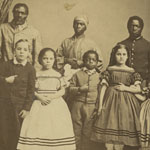 |
Emancipated Slaves. Brought from Louisiana by Col. Geo. H. Banks. M. H. Kimball, albumen print photograph (New York, 1863). |
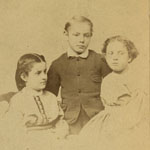
|
Rebecca Huger, Charles Taylor, Rosina Downs. J. E. McClees, albumen print carte-de-visite (Philadelphia, 1863).
This group of freed slaves, ranging in color from black to white, travelled through the North to raise funds for schools in Louisiana. In Philadelphia, three of the whitest children were turned away from the St. Lawrence Hotel “on account of their color.”
|
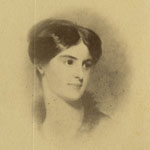 |
Fanny Kemble. Albumen print carte-de-visite, from an engraving (Philadelphia, n.d.). |
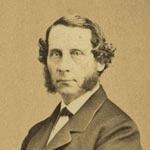
|
Pierce Butler. Albumen print carte-de-visite (Philadelphia, n.d.). |
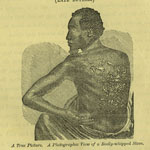 |
From the Journal of a Residence on a Georgian Plantation by Mrs. Frances Anne Kemble, (Late Butler) (Philadelphia, 1863).
This Republican campaign pamphlet condemning the proslavery views of the Democratic gubernatorial candidate features selections from Kemble’s larger book published in New York and London in 1863. The London edition of her account of life on her husband’s Georgia plantation helped check the recognition of the Confederacy by the British. Kemble’s former husband, prominent Philadelphian Pierce Butler, was imprisoned for championing Southern views in 1861. The cover illustration shows a slave named Gordon, taken from Harper’s Weekly for July 4, 1863. |
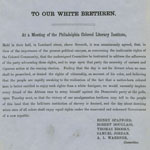
|
To Our White Brethren (Philadelphia, 1862).
This appeal urging voters to support Republicans is a Democratic fraud, published to incite racial animosity. The give-away here is the reference to Republicans as “our amalgamation brethren.” “Amalgamation” was the term for interracial association, with strong sexual implications, sure to excite white anger. |
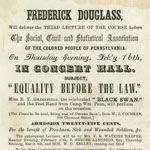 |
Social, Civil and Statistical Association, Frederick Douglass, Will deliver the Third Lecture of the Course . . . Subject, “Equality Before the Law” (Philadelphia, 1865).
William Still was the African American leader of the local Underground Railroad during the 1850s, an early voice calling for allowing blacks to ride the streetcars, and here campaigning for the adoption of the 14th Amendment. In 1874 he would break with the Republican establishment over their refusal to appoint African American police officers. |

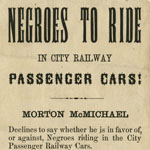
|
William Still, from his book The Underground Railroad (Philadelphia, 1872).
Negroes to Ride in City Railway Passenger Cars! (Philadelphia, 1867).
Democrat Daniel M. Fox, responding to the black campaign to ride the streetcars, made it a central issue in his mayoral bid. At the time, a poll of white streetcar riders supported the continued exclusion of blacks. Philadelphians had nothing to do with the eventual desegregation of the streetcars, mandated by the State Legislature later in 1867. |

|
Octavius V. Catto, from Harper’s Weekly, October 28, 1871.
The educator, civil rights activist, and champion baseball player elevated Still’s early formal protests over the streetcar issue to a direct-action campaign, launching the first Freedom Rides here in Philadelphia as blacks boarded the cars and were quickly ejected. Acting in concert with African Americans throughout the North through the National Equal Rights League, Catto agitated extensively for the 14th and 15th Amendments. Pennsylvania Blacks’ voting rights were restored after passage of the 15th amendment in 1870. Catto was assassinated on election day, October 10, 1871, while mobilizing blacks to exercise their newly-won right to vote. |
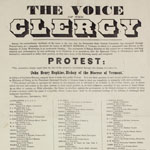 |
The Voice of the Clergy (Philadelphia, 1864).
Pennsylvania Democrats republished Episcopal Bishop John Henry Hopkins’s proslavery work The Bible View of Slavery as a campaign document, triggering this denunciation by the Episcopal clergy of Pennsylvania. The reprint of Hopkins’s work set off the last great pamphlet war in the age of American slavery. The Library Company holds fifteen pamphlets published in response to Hopkins and the Democrats. |
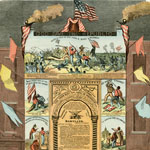 |
Supervisory Committee for Recruiting Colored Regiments, Emancipation in Maryland (Philadelphia, 1864).
This dramatic painted transparency celebrating Maryland’s abolition of slavery was displayed at the Supervisory Committee headquarters. Notice the cheering crowd of whites admiring this scene of armed black soldiers attacking whites. It was a new day. In a previous generation such a public display of black militancy would (and did!) spark riots. |
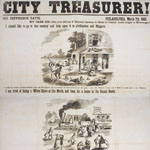

|
City Treasurer! (Philadelphia, 1863).
In this dramatic broadside the Republicans (the National Union Party) revert to their free labor and free soil roots of the 1850s in a stunning attack on Democrat John Brodhead as a lover of slavery who holds white labor in contempt. This broadside is printed on two joined sheets. McAllister collected the top sheet; we purchased the bottom at auction in 2006. In the photograph you can see this and other broadsides in action posted on a wall at the Union League headquarters at 1118 Chestnut St. |













